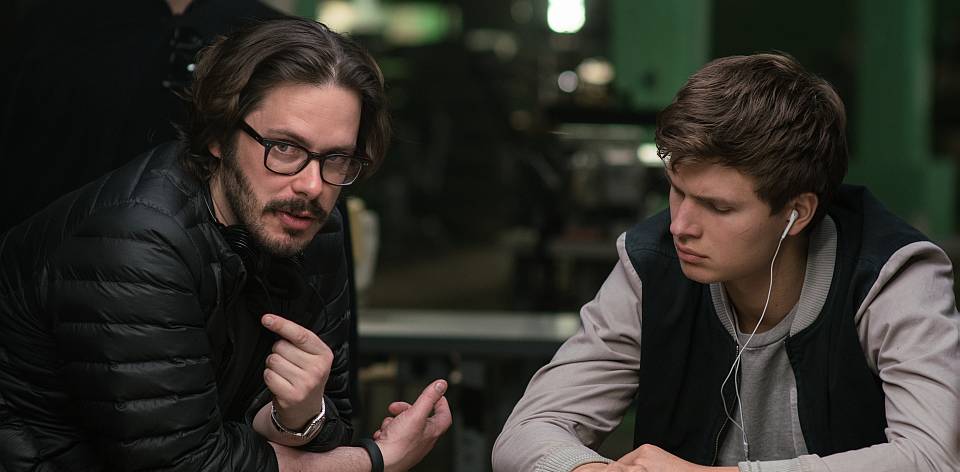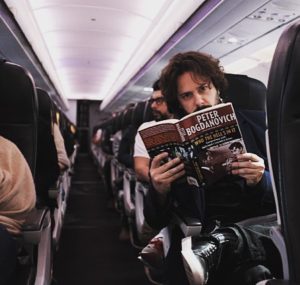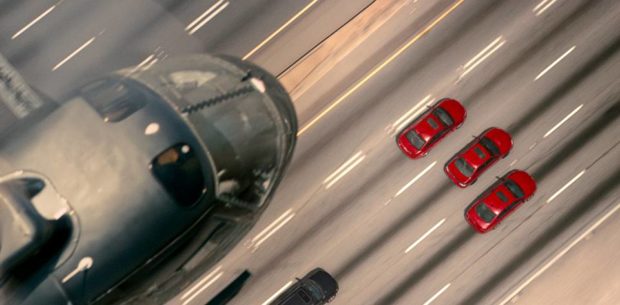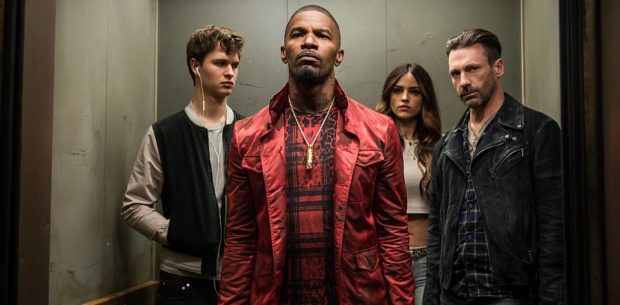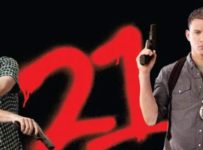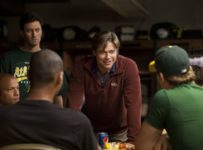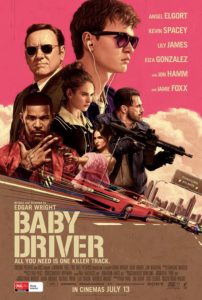
Edgar Wright’s BABY DRIVER is currently exciting film fans all over the world, a blend of his trademark frenetic action and more songs than you can poke a stick at. If song-poking is your thing, of course.
In the film, Baby (Ansel Elgort) is a young and skilled getaway driver, perpetually attached to his earbuds thanks to a childhood accident that left him with permanent tinnitus. Timing his high-speed crimes and lifestyle to the beat of his ubiquitous iPod, Baby’s debt to mob-boss Doc (Kevin Spacey) keeps him on the hook for “one last job.”
For this mini-roundtable interview, we joined forces with Blake Howard of Graffiti With Punctuation to ask Edgar about Peter Bogdanovich, traffic jams in Atlanta, ex-cons and FBIs, deleted scenes, and his ultimate 1974 dream cast.
On Peter Bogdanovich
Inspired by an Instagram photo of Edgar reading Peter Bogdanovich’s Who the Hell’s In It, and Edgar’s extensive mental encyclopedia of film, Blake wanted to know what a dream 1970s or 1980s version of the BABY DRIVER cast would look like. “It’s giving me brain ache,” he admitted, as the parameters of the challenge were narrowed down to 1974.
“The boundaries are very…wide there. Funnily enough Peter Bogdanovich emailed me last night. A) He’d seen the movie, and B) he said somebody told me that you were on Instagram reading my book…I was trying to get out of him, I have this theory and I’m trying to nail him down on it, is that he unofficially rewrote The Wild Angels. So I was trying to get from Peter Bogdanovich, ‘Did you write the speech? That’s in the Primal Scream song, that’s also in The World’s End. You know “I want to be free to do what I do!” I said, ‘Did you write that in?’ He said, ‘I wrote 80% of it, but I don’t actually remember. So I’m going to make him watch it and say ‘Specifically this bit…If you wrote it, that’s major.'”
BABY DRIVER is in Australian cinemas from today, 13 July 2017, from Sony Pictures.
As for the casting, it was a question that Edgar would return to later .
On Atlanta
Anybody who has spent any time in Georgia, or knows someone from the ATL, will know of the regular complaints about the state of traffic in the city. So we wanted to know why Wright set his car chase film in a place where cars were regularly bumper-to-bumper?
“Well, I think the thing is, if you were a great getaway driver like Baby, you need somebody like that to be able to navigate. In a way, you know, looking at it…it was originally written for Los Angeles. When Atlanta came up as a potential, a sort of cheaper place to shoot. Los Angeles is a prohibitively expensive place to shoot for a film like this. So when Atlanta came up, I was a little reluctant at first, and then I said let me go there and think specifically just about this.
I very quickly realised it was a better location. Atlanta has a big music history, and it’s also sort of a big car city. Also: it does have crime, because it is a travel hub of airport, trains, and freeways. It’s the biggest travel hub of the southeast, and as such that also makes it kind of a crime hub, in a way, like any big city is. What’s funny is, when I was there, and started to think about making it there, I started looking. [Mimes typing] I put in “Atlanta car chases police footage,” and lots of bank robberies with people getting straight on the freeway.
Now, the thing is, you need a driver like Baby who would be thinking ahead, thinking about the cut-throughs, and the ways to kind of get away…It’s about being more fleet of foot, and doing exactly what he does in the movie. Rob a bank in midtown, get on the freeway, go to downtown, get into a parking structure, disappear. So if you robbed a bank and went straight onto the I-85 freeway headed north, you are going to very quickly get caught. So I guess the idea is that Baby has the savant like abilities that would make him glide through Atlanta traffic.”
Early cuts and deleted scenes
This tweet from writer/director Christopher McQuarrie inspired Blake’s next question, and we wanted to know what was in this early cut that didn’t make it through to the theatrical version.
https://twitter.com/chrismcquarrie/status/876251854228701187
“It was basically the same movie…We did some re-shoots…There wasn’t anything we cut out, it was sort of an additive thing. About six months after the main shoot we did 4 days of pickups, and we just bolstered a couple of sequences. There was one character who’s death the original cut was more ambiguous. When a test audience is confused as to whether somebody’s alive or dead, then we really need to make sure that character is dead dead.
I changed the first scene with Joe, the foster father. That was originally a bigger dance number that will hopefully be on the DVD. Out of context it was a really fun scene, but I think where it landed in the running order of the film, you could tell that some members of the audience were really enjoying, and some members of the audience were thinking ‘Where is this going, this movie?’ So I changed that and gave Joe a better introduction. In the new version, Joe the foster father was given a much better introduction to the movie. There was an extra scene shot with Ansel and Lily. Sort of little additive bits to punch things up. We added some action to the end sequence as well.”
Advice from ex-cons
As part of the research for the film, Edgar spoke with a number of ex-cons and FBI agents to authenticate the voices in the film. We wanted to know exactly what it was he got out of them under the harsh light of a filmmaker’s interrogation.
“I think the thing is, with an English middle-class kid trying to write an American crime film, the only way I could authenticate it – I could, in theory, be a criminal – but rather than be an actual getaway driver, the next best thing to do is interview ex-cons, and interview ex-bank robbers and ex-getaway drivers. Then you just get a wealth of detail.
So I think initially there was a bunch of stuff a researcher had done, and that had a number of details in it I thought were really interesting. Just the use of everyday cars, the idea of a getaway driver just trying to blend into the flow of traffic. The idea of stealing cars from train stations or airports where they’ll be not reported for a long time. The colour of the cars. The idea that they’re everyday cars. After that, I started to interview ex-cons myself and ask them very general questions about the job, and then very specific questions about the job.
I asked them ‘Would you ever listen to music on the way to a heist?’ Joe Loya, the person who would end up becoming a script consultant, he answered at one point ‘Oh, I would never listen to music on the way to a heist, because I’ve got enough demons up here making music.’ Oh boy, I’ll write that one down. So the other thing that went straight into the movie, I spoke to this other ex-con who’s now a crime writer called Rick Marinick…He said there was this one time. He told the story that we were off to a job, the radio’s on and Guns ‘n’ Roses cover of ‘Knockin’ on Heaven’s Door’ is playing. One of the crew says ‘This song is a jinx, this is a bad vibe, and we should not go in there today because we’re going to die.
That’s the thing. When you write a fictitious movie, you have all these ideas for characters and then you speak to real people and you authenticate them. Then it’s like giving extra colour and detail to fictitious scenarios…So that was fascinating. I loved doing that.”
Recasting the film: 1974 edition
Of course, Edgar wouldn’t let us leave without returning to his dream casting. With 1974 being an important year for the filmmaker, he quickly rattled off a who’s who of talent that would make the ultimate 1970s flick.
BABY: Ryan O’Neill. He was already in The Driver, so he may as well be in this one as well.
BUDDY: Dean Martin [laughs]
DEBRA: 1974 Debora? Goldie Hawn.
BATS: What about Richard Rowntree? No, I want to change it. Let’s say Bernie Casey.
BABY DRIVER is in Australian cinemas from today, 13 July 2017, from Sony Pictures. We’d like to thank the studio for the opportunity to chat with Mr. Wright, and of course, Edgar for taking the time to answer our questions.

